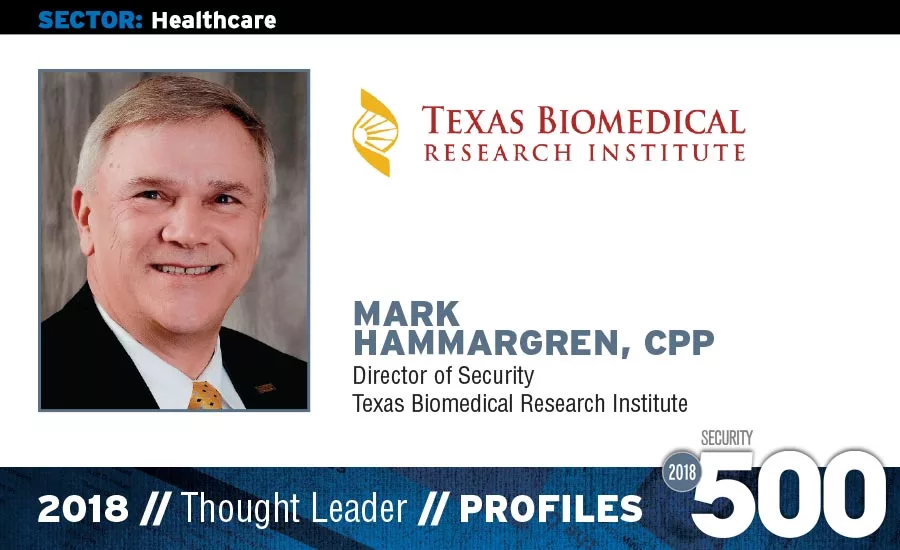Mark A. Hammargren: Delivering Relevant Security

“We are a small but well-known and respected biomedical research facility. For me, it’s about service to our community and ensuring our scientific leaders and support teams are safe and secure against all hazards in order to perform their amazing and innovative scientific research,” says Mark Hammargren, CPP, Director of Security for Texas Biomedical Research Institute.
Hammargren has more than 36 years in the security and law enforcement profession in military and private sectors. He is the Institute’s first security director with responsibility for the planning, direction and coordination of all physical security, law enforcement and emergency management functions for a staff of 360+ employees at a 200-acre biomedical research facility that hosts a Biosafety Level 4 facility and the Southwest National Primate Research Center.
Many of the Institute’s 360 employees are scientists who work to improve human health by being world leaders in lifestyle and infectious disease research. Texas Biomedical partners with researchers and institutions around the world, targeting advances in the fight against cardiovascular disease, diabetes, obesity, cancer, psychiatric disorders, AIDS, malaria and other infectious diseases.
The sheer nature of the Institute’s work means risk, which sometimes manifests in the form of animal activists, some of whom actively recruit people to infiltrate the facility as employees.
“To mitigate this, every employee undergoes two background checks,” Hammargren says. “Our security and emergency management teams are totally committed to ensuring the safety and security of our high-containment laboratory operations and our nonhuman primate animal colonies. Institute wide, we mitigate and manage risk through an aggressive training regime.”
“As a non-profit with aging infrastructure, we need to apply strong risk decision strategies for our future growth,” he adds. “That is why I am applying Enterprise Security Risk Management in our strategic and master planning. We have just completed an aggressive strategic and master plan that will reshape our future science, and I’m excited to be a part of this transformation. It is very important for us to manage our security risks in an effective, consistent and efficient manner.”
In addition to risks from animal activists, Hammargren notes that he and his team (one employee in the Security and Emergency Operations Center, 16 Texas Level III Commissioned Security Officers and one onsite San Antonio Police Department Officer) must understand the needs of the scientific community.
“I’m learning something new every day as this is my first experience working with the scientific research community,” he says. “Our scientists are very focused on their research and their collaboration with peers from academic institutions and other research facilities. I have embraced the challenge of learning more about their scientific research and biosecurity to compliment my many years of experience with traditional physical security and law enforcement. Still, my primary focus is safety and security, ensuring everyone is prepared to handle the wide spectrum of threats we face today from severe weather events and workplace violence to dealing with protests against our research mission. That is our greatest challenge – delivering relevant security and not being a disruption to the science.”
He measures security value by how he and his team deliver the core values of teamwork, integrity, diversity, excellence and safety.
“The core to our effective security and emergency preparedness is based upon living these values with an added emphasis on readiness,” he notes. “When we (our employees and our security team) plan and exercise our capabilities, we can make the best informed decisions to ensure we are prepared to respond and recover from all incidents. That is teamwork at its finest!”
He’s been successful in his mission.
“I know that I have the support of our leadership and from our staff. We recently commissioned a 24/7 Security and Emergency Operations Center that has the charge of coordinating our emergency communications, security dispatching; management of emergency response efforts; monitoring our integrated Security and Fire Alarms; video surveillance; and other operational functions critical to the Texas Biomedical mission. We are building a robust security and emergency management training and exercise program that has been warmly received.”
In his free time, Hammargren serves in a volunteer leadership role as the Regional Vice President for ASIS International Region 3C (Texas) and enjoys working in his yard, RV camping and taking cruise vacations with his wife.
Critical Issues
1. Maintaining the Safety and Security of Research Mission Against the Insider Threat or Workplace Violence
2. Delivering Facility Protection with an Aging Infrastructure
3. Ensuring the Safety of Animals and Employees Due to Increased Commercial and Hobbyist Use of Drones
Looking for a reprint of this article?
From high-res PDFs to custom plaques, order your copy today!







